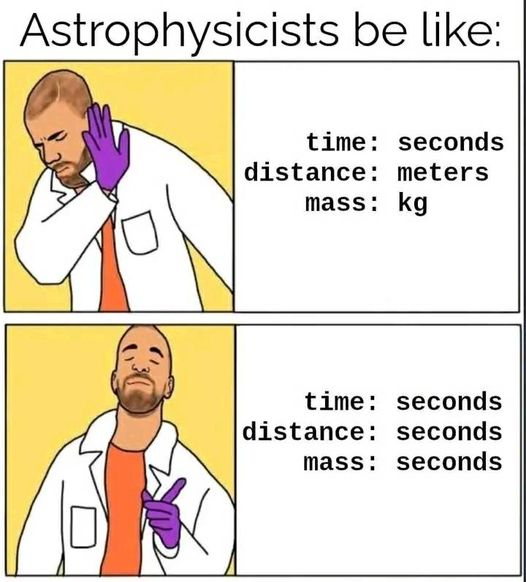I know some people that should measure their weight in mass per second.
Science Memes
Welcome to c/science_memes @ Mander.xyz!
A place for majestic STEMLORD peacocking, as well as memes about the realities of working in a lab.

Rules
- Don't throw mud. Behave like an intellectual and remember the human.
- Keep it rooted (on topic).
- No spam.
- Infographics welcome, get schooled.
Research Committee
Other Mander Communities
Science and Research
Biology and Life Sciences
- [email protected]
- [email protected]
- [email protected]
- [email protected]
- [email protected]
- [email protected]
- [email protected]
- [email protected]
- [email protected]
- [email protected]
- [email protected]
- [email protected]
- [email protected]
- [email protected]
- [email protected]
- [email protected]
- [email protected]
- [email protected]
- [email protected]
- [email protected]
- [email protected]
- [email protected]
- [email protected]
- [email protected]
- !reptiles and [email protected]
Physical Sciences
- [email protected]
- [email protected]
- [email protected]
- [email protected]
- [email protected]
- [email protected]
- [email protected]
- [email protected]
- [email protected]
Humanities and Social Sciences
Practical and Applied Sciences
- !exercise-and [email protected]
- [email protected]
- !self [email protected]
- [email protected]
- [email protected]
- [email protected]
Memes
Miscellaneous
Mass in seconds? How? I get mass in Joules, but seconds?
Well the modern definition of a kg is based off of the second and the metre https://en.m.wikipedia.org/wiki/Kilogram :P
There are two possibilities I can think of:
- Orbit duration can be used to calculate mass
- The diameter of a star or the parallax distance on the sky (in arcseconds) can also be used to evaluate mass
Size doesn't say much about mass though.
I thought stars of similar masses were also of similar sizes. They're not?
I'm no astrologer but from what I've learned, we also need to look at the color to glassify stars into categories. It varies a bit though in each category so it's a blunt tool.
Then there are other objects like gas clouds and even galaxies. For those, we have no idea of the density distribution, so radial size gives us even less info.
I measure the mass of my stool by seconds it takes to discharge
The amount of time a mass M attracts a unitary sphere up into CoM.
I'm hungry for more; may I have seconds?
I don't know anybody using just seconds. I use natural units and my simulation buddies use their funny cgs units.
angle: seconds
Rads. But radians are fine too.
Tau (τ). A full circle is just 1τ instead of 2π.
Yeah, but everything else is more annoying. 1+e^i(0.5τ)=0 just doesn't hit the same
Euler's identity with tau simplifies to:
e^iτ^ = 1
So it's actually simpler. See: https://tauday.com/tau-manifesto#sec-euler_s_identity
Sure, it's simpler; but it's less elegant
Don't they measure distance and time by redshift (ie colour)
What even is color if not seconds^-1?
Yeah true, but I think they actually use wavelength of red shift, which is distance.... traveled by light in the time it takes to make a full cycle. So I guess we're back to seconds again.
I think they use this for distance and time because at scales being dealt with they have the same implications.
They normally use parallax-seconds, i.e. parsecs, for long distance objects.
I think you need to be more specific than 'long distance', yes they use parsecs for 'long distances' but I believe only for intra-galactic objects. I think other galaxies are too distant for parallax seconds to be useful.
Fair!
Thanks for this bit of clarification
Fun fact: Seconds are called seconds because the first breakdown of an hour is the minute, and the second breakdown is the second. Don't ask me the obvious question(s) because I don't know.
If by obvious question you mean “why is it called a minute,” that is because “minute” means “small.” So you have the first minute (small) part and the second minute part of the hour.
As a theoretical physicist, units are for chumps
You must love Reynold’s Number:
Oh god, no fluid mechanics is way too difficult. I stuck to studying quantum effects of black holes, which is much easier.
(This isn't a joke, it's literally true)
It's easy to remember c and ℏ if they're both 1...
Constance? Never heard of her
That may be relativists (they would actually measure anything in units of mass, with everything else defined through G = c = 1). Astrophysicists commonly measure mass in solar masses, long distances in parsec (or kiloparsec, megaparsec), short distances in solar radii or AU, and time in whatever is relevant to their problem (could be seconds or gigayears)
short distances in solar radii
I think astrophycisists and I may have a difference of opinion on the meaning of the adjective short
Me: not smart enough to understand
Brain: Quick! Say something to sound like you fit in!
Me: uh ... I just did the Kessel Run in under 12 parsecs!
But do you remember the Krebs Cycle?
!https://i.ytimg.com/vi/27x0wiuTYoE/maxresdefault.jpg
